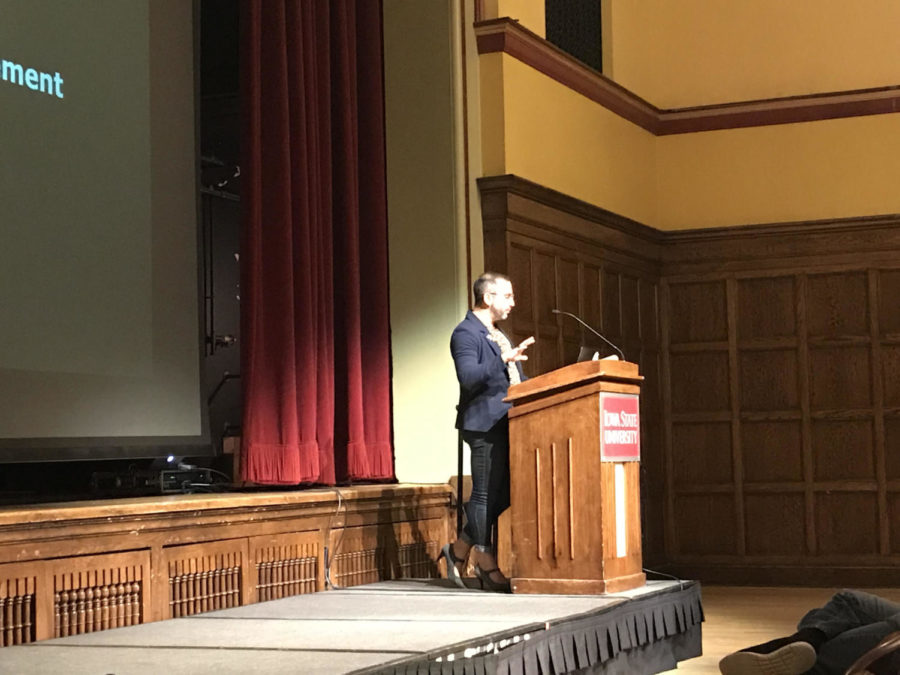Lecturer examines gender in college and everyday life
Madison Mason/ Iowa State Daily
Z Nicolazzo, assistant professor of trans* studies in education and a co-chair of the Transgender Students Research Cluster at the University of Arizona, presented a lecture on gender and how it interacts with college life.
October 8, 2019
Z Nicolazzo, assistant professor of Trans* Studies in Education and a co-chair of the Transgender Students Research Cluster at the University of Arizona, gave a lecture titled “Un/Seen: Gender, College Going and Transgender Student World-Making” Monday in the Great Hall of the Memorial Union.
Nicolazzo’s first point about gender covered the concepts of naturalizing gender and assumed gender and the idea that sex and gender are linked. She discussed the ideas of how gender reveal parties and assuming gender in relation to sex is a way society naturalizes gender, when in reality gender is more complicated than a biological association.
The point was also brought up of how gender is apparent in college campuses worldwide. Nicolazzo brought up this idea of a gender-binary discourse within the environment on campuses.
She referred to an example of how if a couple kisses under the archway of a certain building on a campus, the couple will get married.
This is similar to the tradition at Iowa State regarding the Campanile. Nicolazzo said she brought up this example in order to give the attendees insight into how college campuses can ingrain gender stereotypes as well as heterosexual norms coded within traditions and buildings on college campuses.
“It goes into the sedimented idea of the naturalization of gender,” Nicolazzo said. “This actually carries across classes and across cohorts. This isn’t just something that’s happened recently, it’s been happening for a long time and persists across time. That’s how we understand the real embeddedness of cultural discourses.”
Nicolazzo reminded the audience that gender and sexuality walk very much hand in hand, but are two completely separate concepts. While sexuality is a part of the stereotyping that has been happening for decades on college campuses the same way gender has been, sexuality is different.
Nicolazzo made the point that gender, as well as gender oppression, is a part of everyday life, especially in relation to concepts like settler colonialism, anti-black racism, classism and compulsory able-bodiedness. And ultimately, while gender is a guiding factor in one’s life, it still disappears within the bigger picture of society.
Nicolazzo brought up the emphasis on people who are transgender. She talked about how transgender people seem to be held to a different standard in relation to gender and the beauty standards behind that gender, such as trans women conforming to feminine beauty standards, especially black trans women, who are seen as masculine unless represented as hyper feminine.
“I want to talk about how Laverne [Cox] and [Indya Moore’s] blackness has a particular effect in the world,” Nicolazzo said. “Both are indeed trans, but both have to be hyper feminine in order to be legible as trans.”
Nicolazzo made her final points by talking about gender possibility as well as impossibility.
She talked about how there is a current reality surrounding gender that is apparent on and off campus. Trans oppression, sexism, classism, anti-black racism, ageism, transmisogyny and compulsory able-bodiedness are just a few terms or conditions in which gender identity have to go through in society today.
Nicolazzo ended the lecture by mentioning a small snapshot of the U.S. Supreme Court case argued Tuesday that has to do with the LGBTQIA+ community, and how the ruling can affect trans and queer people alike. She said she wanted attendees to acknowledge the community is doing their best under the situation and cards that have been dealt, and there is a need to protect each other, because that is what is needed at the moment — advocacy and protection for one another.
“We’ve been struck with this sense of hopelessness, but what my research has actually been showing is that we’ve already been protecting each other,” Nicolazzo said.
When asked during the Q&A session how being transgender compares to being a tomboy/tomgirl, Nicolazzo responded there’s no article of clothing marking people as trans.
“When we come out as trans, we don’t get a free t-shirt in the mail; we do, however, get a package of glitter though,” Nicolazzo said, smiling. “Being trans is a felt experience. It is something that is much deeper and central to our core being than just putting on some different clothes. I do wonder, however, what the reality of transness would look like if the gender-binary discourse wasn’t so deeply trenched in our culture.”
















